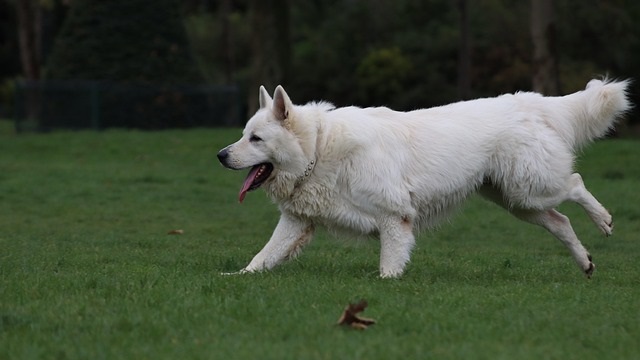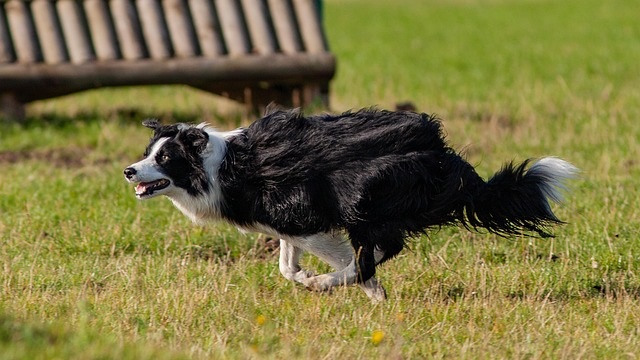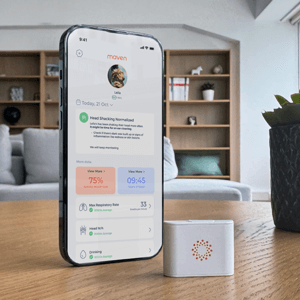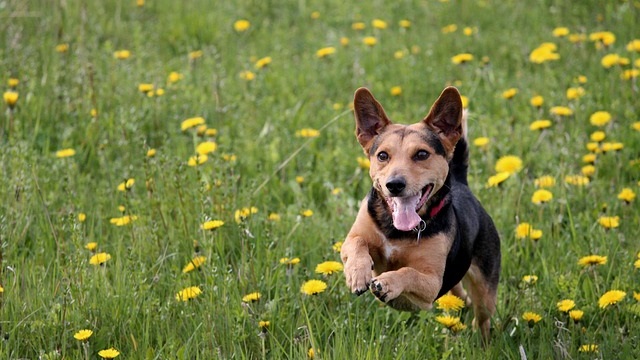Dog Zoomies Explained: Healthy Play or Hidden Anxiety?
You’ve seen it: one moment your dog is calm, the next they’re tearing through the house at warp speed, skidding around furniture, tail tucked or wagging furiously, with that wild look in their eyes.
Welcome to the world of dog zoomies!
These sudden, frantic bursts of energy are hilarious to witness, but are they always “just cute”? What exactly is going on when your dog gets the zoomies? Is it pure joy, or could it be a sign of something else, like anxiety or a need for more stimulation?
Understanding your dog’s behavior is key to their well-being.
This article will dive deep into the phenomenon of dog zoomies, exploring their scientific basis, common triggers, and when they might be more than just healthy play.
Key Takeaways

- Are zoomies normal? Yes, dog zoomies are a completely normal and healthy burst of energy and excitement.
- Why do dogs get the zoomies? Common triggers include excitement, post-bath exhilaration, and a need to release accumulated energy.
- When to worry? While often harmless, excessive or poorly-timed dog zoomies might signal pent-up energy, boredom, stress, or a disrupted routine.
What Are Zoomies, Really?
Scientifically, dog zoomies are known as Frenetic Random Activity Periods, or FRAPs.
During a FRAP, dogs engage in a sudden, intense burst of running, spinning, and often playful barking.
It’s an explosion of energy that typically lasts only a few minutes before your dog collapses in a happy, panting heap. Think of it as your dog’s way of blowing off steam, an instinctual release of built-up energy or excitement.
FRAPs are a natural part of canine behavior. They are not a sign of aggression or instability, but rather a display of heightened arousal that manifests as a physical outburst.
Common Triggers: Why Do Dogs Get the Zoomies?

So, why do dogs get the zoomies? Several common situations can trigger these energetic outbursts:
- Post-Bath Excitement: Many dogs experience a surge of energy after a bath, often accompanied by frantic rubbing on carpets or furniture. The sensory experience of being wet and then dried, combined with the relief of the bath being over, can trigger a celebratory FRAP.
- Evening Energy Bursts: As the day winds down, some dogs, particularly puppies and adolescents, get a “witching hour” where their energy peaks, leading to a round of evening dog zoomies. This can be due to accumulated energy from the day or simply a natural circadian rhythm where their activity levels peak at certain times.
- Stress Release: Sometimes, zoomies can be a way for dogs to discharge nervous energy or stress. If your dog has been in a new environment, had a vet visit, or experienced a change in routine, zoomies might be a healthy coping mechanism to release pent-up tension.
- Play Excitement: An exciting game, a visit from a favorite person, or even just the anticipation of a walk can trigger zoomies as an expression of pure joy and anticipation.
- Pent-Up Energy: If your dog hasn’t had enough physical or mental stimulation throughout the day, zoomies can be a sign that they need to burn off some excess energy. This is particularly true for high-energy breeds or dogs who have been confined for extended periods.
- After Naps or Waking Up: Just like humans might stretch and feel a burst of energy after a good nap, dogs can experience zoomies as they shake off sleep and get ready to be active again.
Are Zoomies Always Healthy? When They May Signal Boredom, Anxiety, or Under-Stimulation
It’s important to differentiate between joyful dog zoomies and those that might signal an underlying issue. In some cases, they might be a cause for closer observation:
- Excessive and Frequent Zoomies: If your dog is having several intense zoomie sessions every day, it could indicate they’re not getting enough exercise. While occasional zoomies are normal, constant FRAPs might suggest an unmet need for physical activity.
- Zoomies at Inappropriate Times: Are the zoomies primarily happening indoors when your dog hasn’t been outside all day? Or perhaps mostly at night, when they should be sleeping? This might suggest you need to provide more exercise during the day.
- Zoomies Accompanied by Other Stress Signals: If the zoomies are paired with other signs of anxiety (like excessive panting, pacing, destructive behavior, or unusual vocalizations), they might be a manifestation of stress or discomfort.
- Lack of Other Engaging Activities: If your dog seems bored and the zoomies are their primary form of activity, it could be a cry for more interaction, training, or varied play.
- Self-Soothing Behavior: In some cases, zoomies can become a self-soothing behavior for dogs feeling overwhelmed or anxious. Observing the context of the zoomies is crucial here.
Puppies vs. Adult Dogs: Normal Age Patterns

The frequency and intensity of dog zoomies often differ between puppies and adult dogs:
Puppies
For puppies, zoomies are incredibly common and a vital part of their development.
Puppy zoomies are almost always a healthy sign of a happy puppy, often occurring after naps, meals, or intense play sessions. These bursts help them burn off excess energy and work on their coordination.
Adult Dogs
While adult dogs still get zoomies, they might be less frequent and more situation-specific (after a long nap, or when particularly excited, for example).
If an adult dog suddenly starts having very frequent or intense zoomies, especially if it’s a new behavior, it’s worth considering if their exercise routine, mental stimulation, or daily schedule needs adjusting.
Should I Take My Dog to the Vet?
“Dog zoomies are a healthy release for many dogs, especially puppies. But if they’re happening more at night, after long inactive periods, or in anxious dogs, it’s worth looking at the bigger picture. Patterns matter.” — Carolina Domingues, DVM.
Dr. Domingues emphasizes a crucial point: context and patterns are key. A single zoomie session is rarely cause for concern. It’s when these behaviors become chronic, disruptive, or are linked to other signs of unusual behavior that you should contact your vet and explain what is happening.
How Maven Helps Decode the Pattern
Understanding your dog’s zoomies and determining if they’re healthy bursts or a signal of underlying issues can be challenging.
It’s hard to remember every single instance or the exact context. This is where Maven comes in!

Maven Pet
Health Monitor
#1 Vet-recommended pet monitor! Tracks activity, rest, respiratory rate, water intake, scratching and other health indicators 24/7
Maven’s pet health tracker helps you track your dog’s daily routines, providing valuable insights into their behavior patterns.
- Bursts After Long Rest? If Maven Pet’s tracker shows frequent, intense activity bursts after long periods of inactivity, it might indicate your dog needs more regular exercise throughout the day. This data can help you adjust their schedule to include more short walks or play sessions.
- Nighttime Zoomies? If the most significant activity spikes are occurring late in the evening, Maven can help you see this trend, allowing you to adjust their exercise schedule to earlier in the day, promoting better nighttime rest.
- Connecting Behavior with Well-being: By observing trends in Maven’s data, you can start to connect zoomie patterns with other aspects of your dog’s life, such as sleep quality, overall activity balance, and potential stress indicators. For example, if Maven’s dog health tracker shows consistently low activity levels throughout the day followed by intense zoomies, it could highlight a need for increased daily stimulation. Conversely, if you notice an increase in zoomies during periods of high stress, the data can help you link the behavior to environmental factors. This allows you to differentiate between moments of joy and a call for more attention to their emotional or physical needs.
- Tracking Routine Changes: Maven allows you to see the impact of routine changes. Did you switch to fewer, longer walks? Did you start a new training class? By observing how these changes correlate with zoomie frequency and intensity, you can refine your dog’s schedule for optimal well-being.
Recap

- Normal Behavior: For most dogs, especially puppies, zoomies are a completely normal and healthy way to release energy and express joy.
- When to Pay Attention: While often harmless, excessive, poorly-timed, or stress-related zoomies might signal pent-up energy, boredom, anxiety, or a disrupted routine.
- Understanding Triggers: Common triggers include excitement, post-bath exhilaration, stress release, and a need to burn off accumulated energy. Knowing these can help you understand why your dog gets the zoomies.
- Puppies vs. Adults: Zoomies are incredibly common in puppies as they develop. In adult dogs, they might be less frequent; a sudden increase could indicate a need for more stimulation or a routine adjustment.
- The Power of Patterns: As Dr. Domingues noted, patterns matter. Observing when and how often your dog experiences zoomies can provide valuable insights into their overall well-being.
- Maven Can Help: Tools like Maven allow you to track your dog’s activity trends, helping you connect zoomie patterns with daily routines, sleep quality, and stress levels, ensuring their needs are met.
Maven Pet focuses on improving the quality of life of our pets with technology, using artificial intelligence (AI) to enable proactive pet care. By accurately collecting and monitoring pet data 24/7 and flagging any irregularities, Maven Pet empowers pet parents and veterinarians to stay ahead of potential health issues, ensuring the well-being and longevity of our beloved companions.




